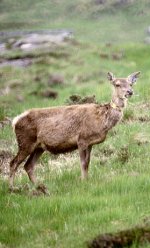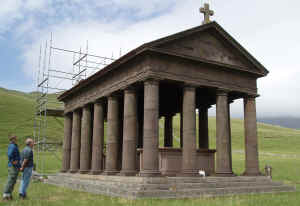KINLOCH CASTLE FRIENDS ASSOCIATION - Rum (Rhum)
|
Rum (or Rhum in some literature) is a diamond shaped island which lies off the west coast of Scotland and covers an area of about 10,700 hectares. It measures only about 13 kilometres between its extreme points. The highest point is the summit of Askival at 812 metres above sea level. The earliest evidence of inhabitation on Rum dates from the Middle Stone Age or Mesolithic period some 9,000 years ago. This is only about 1,000 years after the ice from the last ice age retreated from this area. The settlement, which was close to Kinloch, was probably not permanent as these people are thought to have been nomadic hunter gatherers. There is some evidence of New Stone Age (Neolithic) farmers dating from about 3,000 BC and both Bronze Age and Iron Age inhabitants. Early Christian artifacts from the 7th or 8th centuries have been found and the island would have been under Norse rule from around 800 AD to 1156 when Somerled of Argyll took control of Rum and the other southern islands. It came under Scottish control in 1266 when the Treaty of Perth formally ceded the Hebrides to the Scottish crown. |
The Duke and Duchess of Rothesay visited Kinloch Castle on 1 June 2006. Our Secretary met the Duke and Duchess during their visit. His report may be read by following this internal link. |
In 1870 Rum was sold to Farquhar Campbell and it is thought that he built the "White House". This was originally a shooting lodge but is now the home of the Reserve manager and forms the SNH office on the island. From 1879 the shooting rights were leased to John Bullough, a Lancastrian manufacturer of textile machinery. On the death of Farquhar Campbell the island passed to his cousin James Hunter Campbell. He placed it on the market in 1886 and it was purchased by John Bullough in 1888 for £35,000. John died in 1891 at the early age of 53 leaving the island to his elder son George together with half his business which amounted to around £500,000.
The condition of the Mausoleum deteriorated over the years and by 2006 the fabric was in real danger. The picture above, taken in July 2006 by Graham Bullough of KCFA, shows scaffolding in place as contractors started repair work. It is being inspected by Ewan Macdonald and Douglas King, respectively Chairman and Secretary of KCFA. A report, prepared by the Secretary in August 2006, may be read by following this internal link. The whole of the island has been run as a National Nature reserve since 1957 and forms part of the UNESCO Man and Biosphere (MAB) programme. Owners of RumIn historic times the owners of Rum have been :- To 1845 - Macleans of Coll |
 Rum eventually became the property of the Macleans
of Coll who retained control until 1845. It was then
sold to the second Marquis of Salisbury for £26,455 and
he transformed it into a classic Victorian highland estate.
He was particularly interested in using the island for sport
and re-introduced deer (which had become extinct by the end of
the 18th century). Deer are now common on Rum and walkers have a good chance of a close sighting. The Marquis also built the stone pier at Kinloch which
was the point of arrival until the new deep water facility was
commissioned in 2001. The island was passed on to Salisbury's
eldest son, Viscount Cranborne, and on his death passed to his
younger brother, the third Marquis of Salisbury.
Rum eventually became the property of the Macleans
of Coll who retained control until 1845. It was then
sold to the second Marquis of Salisbury for £26,455 and
he transformed it into a classic Victorian highland estate.
He was particularly interested in using the island for sport
and re-introduced deer (which had become extinct by the end of
the 18th century). Deer are now common on Rum and walkers have a good chance of a close sighting. The Marquis also built the stone pier at Kinloch which
was the point of arrival until the new deep water facility was
commissioned in 2001. The island was passed on to Salisbury's
eldest son, Viscount Cranborne, and on his death passed to his
younger brother, the third Marquis of Salisbury. George built a mausoleum at Harris to house
the body of his father with the intention that it would become
the family resting place.
In 1897 he laid the foundation stone
of Kinloch Castle, the main subject of this website, which was
completed in 1901. In 1903 George married Monica de la Pasture
at Kinloch Castle. They, and their friends, visited regularly
up to the outbreak of the First World War. After the war the
whole life-style changed and Castle was little used with the extensive
gardens becoming overgrown. Sir George died in 1939 and joined
his father in the mausoleum. The island then passed to Trustees
and was sold to the Nature Conservancy in 1957 for £23,000.
The Mausoleum was not included in the sale and still remains
in the hands of the Bullough Trustees. In 1967 Lady Bullough
was also laid to rest there having died at the age of 98.
George built a mausoleum at Harris to house
the body of his father with the intention that it would become
the family resting place.
In 1897 he laid the foundation stone
of Kinloch Castle, the main subject of this website, which was
completed in 1901. In 1903 George married Monica de la Pasture
at Kinloch Castle. They, and their friends, visited regularly
up to the outbreak of the First World War. After the war the
whole life-style changed and Castle was little used with the extensive
gardens becoming overgrown. Sir George died in 1939 and joined
his father in the mausoleum. The island then passed to Trustees
and was sold to the Nature Conservancy in 1957 for £23,000.
The Mausoleum was not included in the sale and still remains
in the hands of the Bullough Trustees. In 1967 Lady Bullough
was also laid to rest there having died at the age of 98.